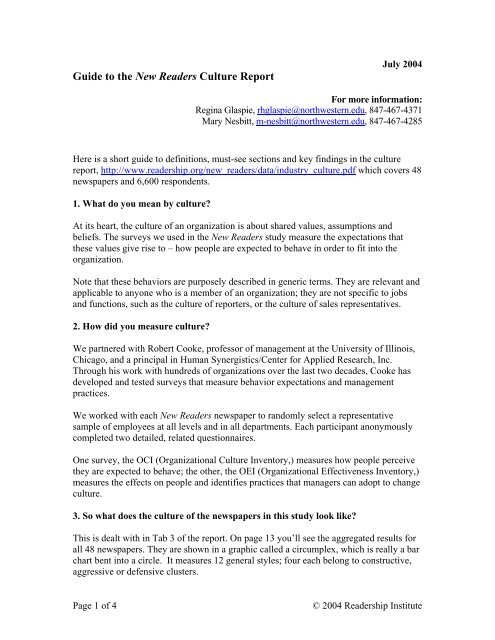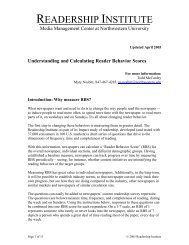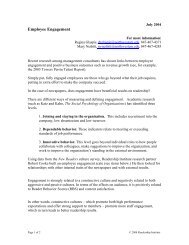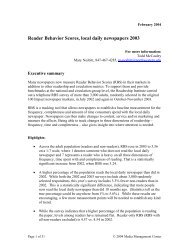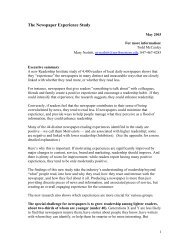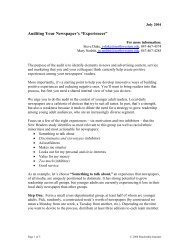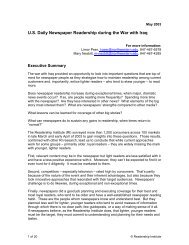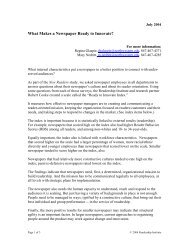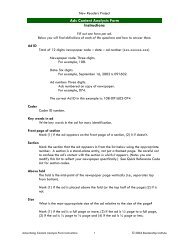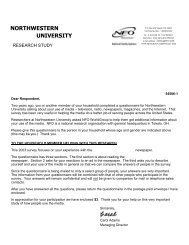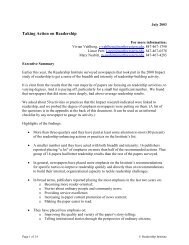Quick Guide to the New Readers culture report - Readership Institute
Quick Guide to the New Readers culture report - Readership Institute
Quick Guide to the New Readers culture report - Readership Institute
Create successful ePaper yourself
Turn your PDF publications into a flip-book with our unique Google optimized e-Paper software.
In any organization, all behaviors are present. What matters is <strong>the</strong> degree <strong>to</strong> which <strong>the</strong>yexist, and how strongly people agree those behaviors are expected.When you look at <strong>the</strong> graphic, identify which styles spike up, and which are at low levels.Ideally, you want <strong>to</strong> have strong constructive styles, weaker aggressive styles and veryweak passive styles.The composite portrait of <strong>New</strong> <strong>Readers</strong> newspapers is aggressive defensive. What thismeans is that people are expected <strong>to</strong> act in ways that protect <strong>the</strong>ir status and security.An especially strong behavior in this <strong>culture</strong> is perfectionism, which means that peopleare expected <strong>to</strong> pay attention <strong>to</strong> detail, never make a mistake and never fail. The upsideof perfectionism is obvious; <strong>the</strong> downside, if perfectionism goes <strong>to</strong>o far, is that <strong>the</strong>organization is slow <strong>to</strong> adapt <strong>to</strong> change; it may focus its perfectionistic efforts on <strong>the</strong>wrong things; and it may strive for <strong>the</strong> unattainable.A second strong behavior is oppositional, where people are expected <strong>to</strong> look for andpoint out mistakes, question everything and strive for objectivity. Again, <strong>the</strong> value of<strong>the</strong>se qualities in some degree is obvious. But if <strong>the</strong>re is <strong>to</strong>o much, <strong>the</strong> organization mayresist change and new ideas for <strong>the</strong> sake of being resistant.Notice that passive defensive behaviors are very much present, <strong>to</strong>o. If aggressive <strong>culture</strong>sare low-risk environments, passive ones are no-risk.Constructive behaviors are least present. Those styles are associated with organizationsthat have a high commitment from and <strong>to</strong> employees, and <strong>to</strong> cus<strong>to</strong>mers. They tend <strong>to</strong> bemore collaborative internally, and in <strong>the</strong> case of newspapers, have higher readership.(For more information on <strong>the</strong> 12 styles, look at pages 9-11 in Tab 3. Pages 19-30 in Tab3 show <strong>the</strong> individual items on <strong>the</strong> questionnaire that relate <strong>to</strong> each style.)Something that cannot be shown graphically on <strong>the</strong> circumplex but is important <strong>to</strong> knowif you are thinking about <strong>culture</strong> change is how intense agreement is among employeesabout <strong>the</strong> kind of behavior that is expected. (See chart on page 14.)Weak agreement indicates <strong>the</strong> behaviors are less firmly embedded, and you will see thisis true for <strong>the</strong> <strong>New</strong> <strong>Readers</strong> newspapers. While <strong>culture</strong> change is never easy (or quick),having weak intensity of agreement especially on <strong>the</strong> defensive styles is an encouragingsign.Pages 31-49 in Tab 3 show <strong>culture</strong> by department, age, race/ethnicity, gender andposition in <strong>the</strong> organization. Overall, <strong>the</strong>re isn’t much difference by race, age or gender.What does make a difference is what department you’re in and where you are in <strong>the</strong>hierarchy.Page 2 of 4© 2004 <strong>Readers</strong>hip <strong>Institute</strong>
Highlights:By department: Advertising, circulation and <strong>the</strong> newsroom are aggressive defensive,while production and “o<strong>the</strong>r” (this includes administration, IT, HR, marketing, online –see list in Appendix, Tab 6) are passive defensive.By age: Aggressive defensive for all groups with <strong>the</strong> exception of 50-60 (passivedefensive.)By race/ethnicity: White non-Hispanics, African-Americans and Hispanics/Latinosexperience <strong>the</strong> <strong>culture</strong> as aggressive defensive, while it is passive defensive for Asian andPacific Islanders.By gender: No difference – aggressive defensiveBy position in <strong>the</strong> organization: Non-management employees experience <strong>the</strong> <strong>culture</strong> aspassive defensive, while line and middle management <strong>report</strong> <strong>the</strong> expectations asaggressive defensive. Upper management, on <strong>the</strong> o<strong>the</strong>r hand, perceive <strong>the</strong> expectations asconstructive – <strong>the</strong> only group in this analysis <strong>to</strong> see things that way.Before leaving Tab 3, look at <strong>the</strong> Ideal <strong>culture</strong> and compare it with <strong>the</strong> current <strong>culture</strong>.(Pages 13–18.) The Ideal profile was derived from <strong>the</strong> 2000 Impact study. It askedrespondents about behaviors that should be expected <strong>to</strong> make <strong>the</strong> newspaper moreeffective and whe<strong>the</strong>r those expectations were realistic. Not surprisingly – professorCooke’s research has shown consistent results across all types of organizations – <strong>the</strong>results showed a preference for a strongly constructive <strong>culture</strong>, with <strong>the</strong> greatest spikes inhumanistic and achievement (people are expected <strong>to</strong> be high performers and <strong>to</strong> supportand encourage <strong>the</strong>ir colleagues).Because <strong>the</strong> results of <strong>the</strong> Ideal diagnostics are predictable, <strong>the</strong> survey was not repeatedin <strong>New</strong> <strong>Readers</strong> and we use <strong>the</strong> Impact Ideal as a proxy.4. This is a picture of all <strong>the</strong> <strong>New</strong> <strong>Readers</strong> newspapers but I’m not sure how relevantit is <strong>to</strong> me -- I’m sure my newspaper is different.There are some differences, but we found in both <strong>the</strong> Impact and <strong>the</strong> <strong>New</strong> <strong>Readers</strong> studiesthat newspaper <strong>culture</strong>s are very similar, regardless of size or location. Almost allnewspapers in <strong>the</strong> <strong>New</strong> <strong>Readers</strong> study had a defensive <strong>culture</strong> of some sort (aggressivedefensive, passive defensive or a mix of aggressive and passive defensive.) Only five hada constructive <strong>culture</strong> and none of those was moderately or strongly constructive.It is possible <strong>to</strong> have a constructive department, or sub-department within an overalldefensive organization.Page 3 of 4© 2004 <strong>Readers</strong>hip <strong>Institute</strong>
5. Isn’t it possible <strong>to</strong> be successful with a defensive <strong>culture</strong>? After all, mostnewspapers have this kind of <strong>culture</strong>, and newspapers could hardly be consideredunsuccessful businesses.True. But, <strong>the</strong> question we would ask is, will this <strong>culture</strong> enable newspapers <strong>to</strong> deal withits readership challenges?Consider <strong>the</strong> following facts from <strong>the</strong> research. In both Impact and <strong>New</strong> <strong>Readers</strong> wefound that as constructive norms streng<strong>the</strong>ned, so did readership. We saw thatnewspapers that had stronger constructive norms also tended <strong>to</strong> be more reader-oriented –<strong>the</strong>y were focused on understanding and responding <strong>to</strong> changes in <strong>the</strong>ir market. Theyalso tended <strong>to</strong> have more engaged employees. And constructive <strong>culture</strong>s put a strongemphasis on what <strong>the</strong> organization accomplishes for cus<strong>to</strong>mers, as well as what <strong>the</strong>individual achieves for himself or herself.To explore that last point in more detail, look at <strong>the</strong> material in Tab 4, which is about <strong>the</strong>outcomes or effects of <strong>culture</strong> on individuals and <strong>the</strong> organization. The bar chart on page52 shows <strong>the</strong> areas where newspapers are stronger and weaker than o<strong>the</strong>r organizations.On <strong>the</strong> plus side, <strong>New</strong> <strong>Readers</strong> newspaper employees <strong>report</strong> greater motivation andintention <strong>to</strong> stay and less stress. But a major weakness is inter-unit coordination, followedby job insecurity, poor teamwork and cooperation within <strong>the</strong> work unit, and quality ofservice at <strong>the</strong> organizational level. Three of <strong>the</strong> four significant weaknesses have <strong>to</strong> dowith how well people interact for a common cause.Pages 59-64 show <strong>the</strong> results broken down by department.6. How do we identify practices that can help change <strong>culture</strong>?Tab 5, levers for change, offers some insight in<strong>to</strong> management practices and o<strong>the</strong>r aspectsof work life that that can help alter <strong>culture</strong>. The bar chart on page 69 shows <strong>the</strong> levers onwhich newspapers already perform above average and those on which <strong>the</strong>y are sub-par.You will see <strong>the</strong> latter outnumbers <strong>the</strong> former by about two <strong>to</strong> one.We would suggest focusing on <strong>the</strong> far right of <strong>the</strong> scale, with <strong>the</strong> greatest negative gaps.Look for practices that are related <strong>to</strong> each o<strong>the</strong>r (pages 73-86) and how <strong>the</strong>y cluster in<strong>to</strong>bigger categories. As an example, we note that every item under supervisory/managerialleadership is a large opportunity for improvement: interaction facilitation (which is a longway of saying “coaching”), task facilitation (team-building), goal emphasis andconsideration.Page 4 of 4© 2004 <strong>Readers</strong>hip <strong>Institute</strong>


